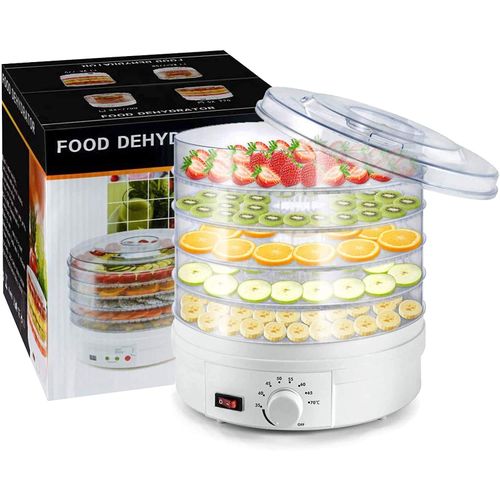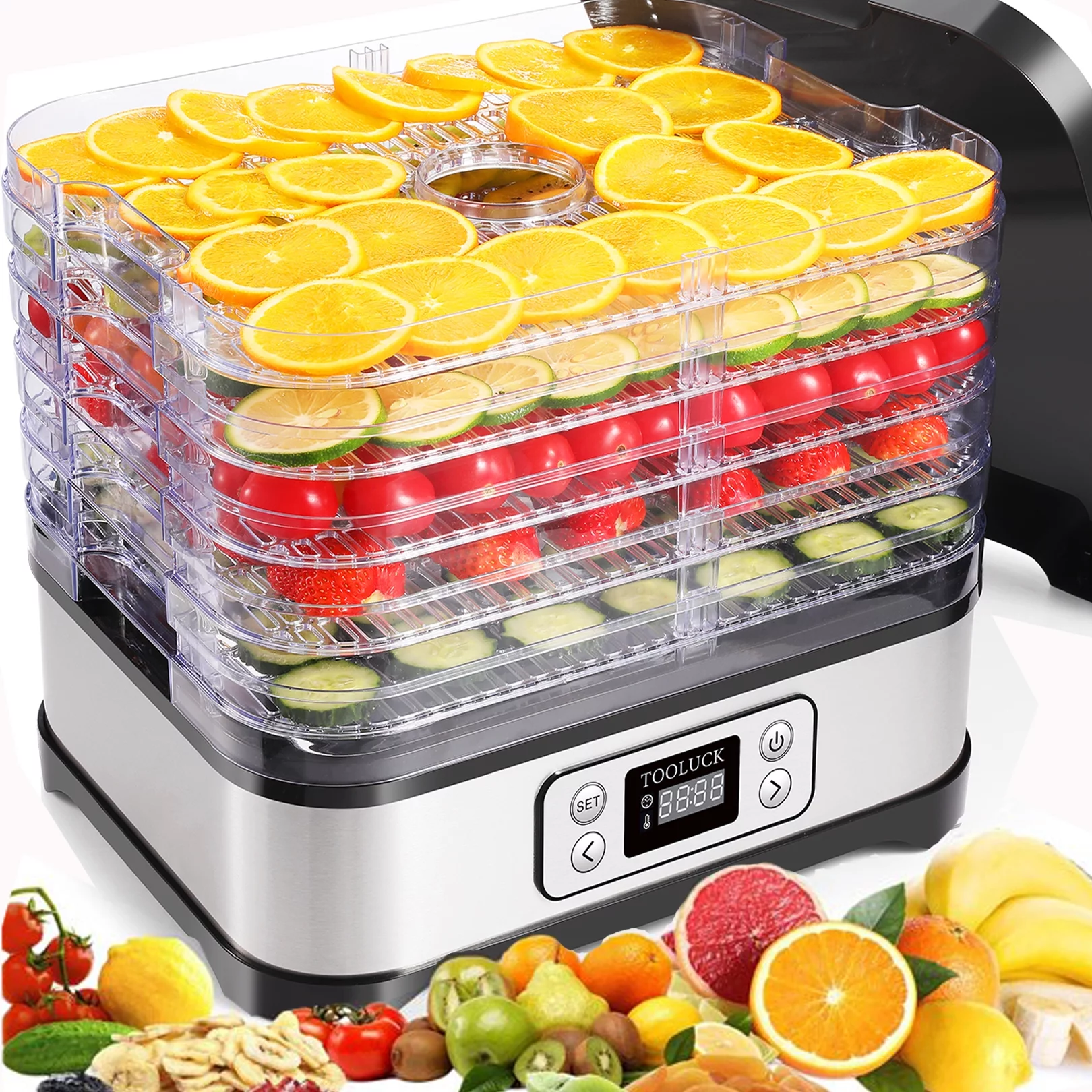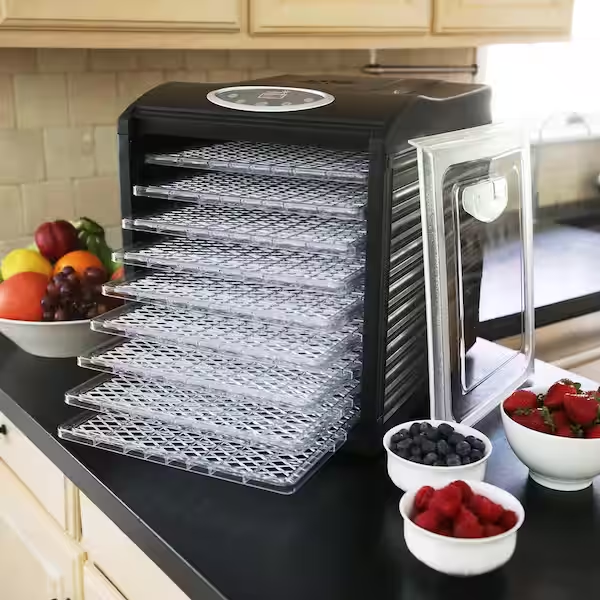Unleashing Flavor: The Art and Science Behind Dehydrators
Discover the magic of dehydrators—a culinary game-changer. From controlled heat to even airflow, learn how these appliances transform fresh foods into nutrient-packed, shelf-stable delights. Navigate the world of dehydration, creating lightweight snacks that captivate the palate and extend the lifespan of your favorite ingredients.
Unlocking the Secrets: How Dehydrators Preserve and Transform Foods

At its core, a dehydrator is a kitchen appliance designed to remove moisture from food, preventing bacterial growth and decay. By circulating warm air around the food items placed on trays, dehydrators gradually draw out moisture, leaving behind a concentrated, nutrient-rich snack that retains its original flavors.
Types of Dehydrators:
- Stackable Tray Dehydrators:
- Ideal for beginners, these dehydrators consist of stackable trays that can be expanded or reduced based on the quantity of food. They are user-friendly and cost-effective.
- Vertical Air Flow Dehydrators:
- With a vertical air flow system, these dehydrators ensure even drying across all trays. They are suitable for a variety of foods and are known for their efficiency.
- Box or Shelf Dehydrators:
- Often favored by serious enthusiasts, these dehydrators mimic the structure of an oven, with horizontal air flow. They offer ample space for drying large quantities of food simultaneously.
- Drum Dehydrators:
- A lesser-known option, drum dehydrators use a rotating drum instead of trays. They are compact, energy-efficient, and provide consistent drying results.
Benefits of Dehydrating:
- Preservation of Nutrients:
- Dehydrating preserves the nutritional content of food, unlike some other preservation methods that may lead to nutrient loss.
- Extended Shelf Life:
- The removal of moisture prevents the growth of bacteria and molds, extending the shelf life of dehydrated foods significantly.
- Compact Storage:
- Dehydrated foods occupy less space, making them an ideal solution for those with limited storage capacity.
- Versatility in Snacking:
- Create an array of healthy snacks such as dried fruits, vegetable chips, and jerky, offering a convenient and tasty alternative to store-bought options.
Tips for Selecting the Best Dehydrator:
- Consider the Size:
- Choose a dehydrator that suits your intended usage. For smaller batches, a stackable tray dehydrator might suffice, while larger volumes may require a box or shelf dehydrator.
- Temperature Control:
- Opt for a dehydrator with adjustable temperature settings to accommodate a variety of foods. Different items may require different drying temperatures.
- Air Flow System:
- A dehydrator with an efficient air flow system ensures uniform drying across all trays. Look for models with horizontal or vertical air flow for consistent results.
- Ease of Cleaning:
- Select a dehydrator with removable and dishwasher-safe trays for easy cleaning. This feature saves time and effort in maintaining the appliance.
- Additional Features:
- Some dehydrators come with extra features such as timers, automatic shut-off, and even built-in temperature and humidity sensors. Evaluate these based on your preferences and needs.
FAQ
How does my dehydrator work?
A dehydrator works by removing moisture from food through a controlled application of heat and airflow. The basic principle involves circulating warm air around the food, causing the moisture in the food to evaporate. Here's a breakdown of how a typical dehydrator operates:
- Heating Element:
- Dehydrators are equipped with a heating element that generates heat. The heating element is responsible for warming the air inside the dehydrator.
- Fan:
- A fan is incorporated to ensure even distribution of heat throughout the dehydrator. It helps maintain a consistent temperature across all trays, promoting uniform drying.
- Temperature Control:
- Most dehydrators come with adjustable temperature settings. Users can set the desired temperature based on the type of food being dehydrated. Different foods require different temperatures for optimal drying.
- Trays or Shelves:
- The food is placed on trays or shelves inside the dehydrator. These trays are usually made of materials that allow air to circulate around the food, aiding in the drying process.
- Airflow:
- The combination of the heating element and fan creates a continuous airflow inside the dehydrator. This airflow is crucial for carrying away the moisture released from the food during the drying process.
- Thermostat:
- Some advanced dehydrators feature a thermostat that monitors the temperature inside the unit. If the temperature deviates from the set level, the thermostat adjusts the heat output to maintain the desired temperature.
The Dehydration Process:
- Preparation:
- Prepare the food by slicing it into even pieces. Thinner slices generally dehydrate more quickly.
- Loading Trays:
- Arrange the food pieces on the trays in a single layer. Avoid overcrowding to ensure proper air circulation.
- Setting Temperature:
- Set the temperature on the dehydrator based on the recommendations for the specific food you are drying.
- Turning on the Dehydrator:
- Switch on the dehydrator to initiate the drying process. The heating element warms the air, and the fan circulates this warm air around the food.
- Monitoring Progress:
- Periodically check the food's progress. Rotate trays if necessary to ensure even drying. Some foods might be ready in a few hours, while others may take longer.
- Completion:
- Once the food reaches the desired level of dryness—where it is tough and leathery but not brittle—it is ready for consumption or storage.
Can you dehydrate raw meat?
Yes, you can dehydrate raw meat using a food dehydrator. Dehydrating raw meat is a common method of preserving it, and it results in items like beef jerky or turkey jerky. Here's a general guide on how to dehydrate raw meat:
Steps to Dehydrate Raw Meat:
- Choose Lean Cuts: Select lean cuts of meat for dehydration. Trim off excess fat as it doesn't dehydrate well and can lead to spoilage.
- Prep the Meat: Slice the meat into thin strips or bite-sized pieces. The thinner the slices, the faster and more evenly the meat will dehydrate.
- Marinate (Optional): Marinating the meat before dehydration can enhance flavor. Use a marinade of your choice, containing ingredients like soy sauce, Worcestershire sauce, garlic, and spices. Allow the meat to marinate for a few hours or overnight in the refrigerator.
- Pat Dry: Before placing the meat in the dehydrator, pat it dry with paper towels to remove excess marinade and surface moisture. This helps in the dehydration process.
- Arrange on Dehydrator Trays: Lay out the meat strips or pieces in a single layer on the dehydrator trays. Make sure they are not touching to allow proper air circulation.
- Set Dehydrator Temperature: Set the dehydrator to the recommended temperature for meat. Typically, it's around 145°F (63°C) or higher. This temperature range is important to ensure the meat reaches a safe internal temperature during the drying process.
- Monitor and Rotate: Periodically check the progress of the meat, rotating the trays if necessary for even drying. The drying time can vary based on factors such as meat thickness and humidity levels.
- Check for Doneness: The meat is done when it reaches the desired level of dryness. It should be tough and leathery, but not brittle. It's important to achieve sufficient dehydration to prevent bacterial growth.
- Cool and Store: Allow the dehydrated meat to cool completely before storing it. Store the dehydrated meat in airtight containers or vacuum-sealed bags to maintain freshness.
What is a substitute for a dehydrator?
If you don't have a dehydrator, there are alternative methods to achieve similar results in drying or preserving food. Here are some common substitutes for a dehydrator:
1. Oven:
- Method: Use your conventional oven at its lowest temperature setting (usually around 170°F/77°C). Prop the oven door open slightly to allow moisture to escape.
- Pros: It provides consistent low heat.
- Cons: It may use more energy compared to a dehydrator, and the process might take longer.
2. Air-Drying:
- Method: Place the food in a well-ventilated area with low humidity. Use a fan to enhance air circulation.
- Pros: Simple and requires no special equipment.
- Cons: It may take longer, and the results can vary based on climate conditions.
3. Microwave:
- Method: Some microwaves have a dehydrate setting. Alternatively, use low power settings to slowly dry the food.
- Pros: Quick and convenient.
- Cons: Results can be uneven, and not all microwaves have a dehydrate function.
4. Sun Drying:
- Method: Place the food in direct sunlight on a hot, dry day. Use screens or trays to elevate the food for better air circulation.
- Pros: Natural and energy-efficient.
- Cons: It relies on weather conditions, and it might take several days.
5. Paper Bag Method:
- Method: Place sliced fruits or herbs in a paper bag, leaving it slightly open. Hang the bag in a warm, dry place.
- Pros: It's a simple and low-tech method.
- Cons: It works best for herbs and might not be suitable for all types of foods.
Where do you put a dehydrator?
When placing a dehydrator, consider factors such as ventilation, noise, and safety. Here are some tips on where to put a dehydrator:
- Ventilation:
- Location: Choose a well-ventilated area. Dehydrators produce heat and moisture during the drying process, and proper ventilation helps prevent the accumulation of humidity.
- Avoid Closed Spaces: Avoid placing the dehydrator in enclosed spaces without adequate ventilation, as this can lead to moisture buildup and affect the dehydration process.
- Air Circulation:
- Open Spaces: Place the dehydrator in an open area where there is good air circulation. This helps disperse heat and allows the dehydrator to work efficiently.
- Safety Considerations:
- Keep Away from Water: Ensure the dehydrator is placed away from water sources to prevent any accidental spills or contact with liquids.
- Noise Level:
- Consideration: Dehydrators can produce some noise, especially models with fans. If the noise level is a concern, place the dehydrator in a location where it won't disturb quiet activities or sleep.
- Kitchen or Utility Room:
- Common Areas: Many people place their dehydrators in the kitchen due to the convenience of food preparation. Alternatively, a utility room or another dedicated space can be suitable.
- Temperature Sensitivity:
- Avoid Extreme Temperatures: Avoid placing the dehydrator in areas exposed to extreme temperatures. Excessive heat or cold can affect the performance of the dehydrator.
- Flat Surface:
- Stable Placement: Ensure the dehydrator is placed on a stable, flat surface. This helps prevent any accidental tipping during operation.
What are 2 disadvantages of dehydrating food?
While dehydrating food is an excellent method for preserving and creating lightweight, shelf-stable snacks, it does have some disadvantages. Here are two notable disadvantages:
- Loss of Nutrients:
- Vitamin and Enzyme Loss: The dehydration process involves exposing foods to heat for an extended period, which can lead to the loss of some heat-sensitive nutrients, such as certain vitamins (e.g., vitamin C) and enzymes. While dehydrated foods still retain a significant portion of their original nutritional value, they may not be as nutrient-dense as their fresh counterparts.
- Texture and Flavor Changes:
- Texture Alteration: Dehydrated foods often undergo a change in texture. Fruits can become chewy or leathery, and vegetables may turn crisp or brittle. While some people enjoy these textural changes, others may find them less appealing compared to the fresh versions.
- Flavor Concentration: The removal of water during dehydration can lead to a concentration of flavors, intensifying the taste of the food. While this can be desirable in some cases, it may not be preferable for all foods, and certain items may become overly sweet or salty.
A dehydrator is a kitchen appliance designed to remove moisture from food, preserving it through controlled heat and airflow. The key components include a heating element, a fan for even air circulation, adjustable temperature settings, and trays for arranging food. During the dehydration process, the heating element warms the air, the fan circulates it around the food, and moisture evaporates, leaving behind lightweight, shelf-stable snacks. While dehydrating, users should monitor progress, rotate trays for even drying, and consider factors such as consistent slicing and proper storage for optimal results. Dehydrators offer a convenient way to create nutritious, long-lasting snacks and can be used for a variety of foods, from fruits and vegetables to meats. Despite some loss of nutrients and textural changes, the advantages of extended shelf life and flavor concentration make dehydrators valuable tools in the kitchen.








